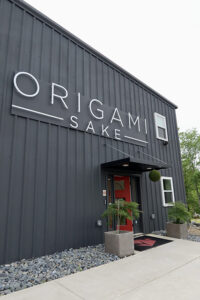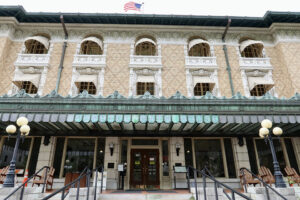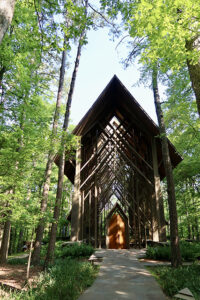
Hidden Gems in Hot Springs:From sake to vegan and mining for crystals
Story and photography by Shilo Urban
Deep in the dark green forest, crystal-clear waters bubble up into steaming pools, and glassy gemstones tumble out of the earth. Strange folk speak of unicorns, and alchemists transform ancient rainfall into spirit-lifting elixirs. Treehouses tower over pathless woodlands, a child’s storybook comes to life. But this is no fantasy realm — it’s Arkansas. Tucked into the timbered wilderness a five-hour drive from Fort Worth, Hot Springs has surprises up its sleeves.

Origami Sake brews exquisite rice wine from spring water and serves it ice-cold.
You can sip exquisite rice wine in stemware at Origami Sake, a tasting room/mad scientist lab that brews the libation with spring water and serves it ice-cold. A glass of their White Lotus sake, opaque and complex, just might change your definition of the drink. Nibble just-baked vegan croissants or try the nutty hummus with housemade pita (the chef is Greek) at Kollective Coffee + Tea. Their artisanal teas and espresso drinks check all the boxes: organic, fair-trade, sustainable and delicious. From eclectic characters to architectural wonders, intrepid travelers to Hot Springs will find abundant curiosities to enjoy.
Hot Springs National Park is nestled in the Ouachita Mountains, whose old-growth forests of hickory, oak and pine are a balm for my dust-caked Texas soul. I wake to their green embrace inside my treehouse at In the Trees, a new collection of cabins perched over a precipitous drop. The forest quickens with life in the periwinkle morning; deer roam below and the far-off knock-knock-knock of a woodpecker echoes through the trees. Birdsong wraps me in a woodland world of melodious warbles — all from the utter luxury of a treehouse with a hot tub and heated bathroom floors.
Hotter still are the 47 thermal springs in the national park, which produce 700,000 gallons of water each day at a toasty 143 degrees Fahrenheit. The pristine spring water fell as rain around the time that Stonehenge was built, embarking on a 4,400-year journey down into the earth before surging back to the surface along a fault line. Frontier settlers flocked to the mineral waters in the early 1800s and built wooden shacks atop the springs where they could soak. The area was designated a federally protected resource in 1832, but this didn’t stop the development of grander and grander bathhouses — making Hot Springs National Park a unique urban enclave with both natural and cultural delights.
Taking the Waters
Hot Springs centers on Bathhouse Row, eight stately structures that evoke the golden age of medical bathing. Built between 1892 and 1923, they showcase several architectural styles including Roman Gothic, Spanish Mission and Renaissance Revival. They were medical facilities that required a prescription for all visitors, who hoped to cure ailments as varied as arthritis, back pain, syphilis, polio, cancer or even the hiccups. Twenty-one baths over two weeks was the standard dose.
After “taking the waters,” patients strolled the red-and-yellow-brick Grand Promenade. It still runs behind the bathhouses alongside steaming springs and a lush green lawn. At one end, a warm cascade spills down the hillside; a jug-filling station caps the other. And all along Bathhouse Row, thermal fountains gurgle and splash. Besides walking and soaking, patients could try cutting-edge treatments at the bathhouses. Some have endured (exercise and physical therapy), and some have not (electric baths and mercury rubs).

The writer’s lodging inside a treehouse at the new In the Trees was a perfect place to decompress. In the Trees is perched over a precipitous drop and forest that quickens with life in the morning.
The bathing trend subsided and by the 1980s, all the bathhouses were closed save one: the Buckstaff, which still offers a traditional bathing experience.
I sign up for the full package and take a gilded, century-old elevator up to the women’s floor. My treatment starts with a private soak in the famous spring waters, cooled to 102 degrees and bubbling in my massive bathtub. Next I climb into a metal box and poke my head out the hole in the top. It’s an old-fashioned vapor cabinet, a personal steam locker, and sweat pours off my body as I look around above like a bobblehead turtle.
A sitz bath follows in a low, shallow sink with just enough room for sitting and the highest temperature yet. After drinking several glasses of ice water under the direction of my bath attendant Mattie, she mummy-wraps me in steaming hot towels with efficient precision. I lie down and bake for a while until the grand finale, a full body massage. I emerge glowing pink and totally relaxed. Part alternative health clinic, part hydrotherapy and part living history — the Buckstaff is an only-in-Hot Springs experience.
For those who prefer hot stone massages to sitz baths, the Quapaw Baths & Spa (two doors down) reopened in 2008 with a modernized menu of treatments.
Most of the historic bathhouses have been adapted for other uses, including a cultural center, bookstore and boutique hotel. Fordyce Bathhouse functions as the park’s visitor center and a museum of the glamorous bathing era. Peek inside to see elaborate stained-glass ceilings, ornate statues and intricate tile floors that would have felt right at home on the Titanic.

Superior Bathhouse Brewery, in a circa 1916 bathhouse that sat vacant for decades, is a craft brewery and restaurant. Giant tanks of beer have replaced bathtubs on the tile floors, and the bathhouse’s original check-in desk serves as the front bar. A dog-friendly patio offers the best views in town.
Athletes like Babe Ruth worked out in the old-timey gym up top, still stocked with wooden dumbbells and climbing ropes. Ruth and other Major League Baseball players traveled to the bathhouses to “boil out” all the booze after lazy winters of revelry, which made Hot Springs the birthplace of spring training. They were joined by notorious gangsters. Al Capone, Bugsy Siegel and Bugs Moran also came for the clear waters … and for the “clear” (moonshine) and copious illegal gambling.
Everyone mingled with jazz musicians and movie stars at The Ohio Club, a 1905 casino that’s now a lively bar and restaurant with whiskey-infused wagyu burgers. Look for the holes in the floor about 6 feet from the entrance; they’re all that’s left of the false wall installed during Prohibition to hide the speakeasy in back.
At the end of Bathhouse Row is the only place on the planet making beer with thermal spring water: Superior Bathhouse Brewery. The 1916 bathhouse sat vacant for decades before homebrewer/entrepreneur/tuba player Rose Schweikhart tried her hand at transforming it into a craft brewery and restaurant.
It worked. Giant tanks of beer have replaced bathtubs on the tile floors, and the bathhouse’s original check-in desk serves as the front bar. Snag a seat on the shaded patio and order a pint paired with the best views in town. My favorite is the Tiny Phazy pale ale, a refreshing palate-pleaser with a pineapple touch — perfect with the sweet potato and spinach salad with spicy-sugar bacon and ginger carrot vinaigrette.

Garvan Woodland Gardens’ wood-and-glass Anthony Chapel was designed by the Fayetteville architects Maurice Jennings and David McKee. Its beams vault toward the sky in a stirring visual symphony with the tall trees outside.
Nature’s Marvels
Beers and baths aren’t the only liquid attractions around; many travel to Hot Springs for its three lakes. Lake Hamilton is the top draw at Lookout Point Lakeside Inn, a boutique getaway with gorgeous gardens and an elegant insouciance. Every one-of-a-kind room is laden with luxuries like four-poster beds and bathroom chandeliers. Balconies overlook the serene shimmers of the water and beckon me to linger.
But I’m here for the forest. I venture to Garvan Woodland Gardens on the far side of the lake, a botanical oasis with brilliant bursts of flowers and scampering chipmunks. Peacocks strut and paths meander past waterfalls and footbridges in the Japanese Garden. I’m drawn to the soaring wood-and-glass sanctuary of Anthony Chapel. Chocolate-colored beams vault toward the sky in a stirring visual symphony with the tall trees outside. Sunlight dances down through the leaves and branches to play on the chapel’s floor. The masterpiece was designed by Fayetteville architects Maurice Jennings and David McKee, associates of the internationally renowned Fay Jones (a protege of Frank Lloyd Wright).
Walking back through the woods I wind up at a three-level treehouse with so much personality it almost seems alive, a behemoth of curving timbers or perhaps a time-traveling Viking airship. I half-expect Ewoks to pop out of the door. Schoolchildren in matching red shirts flit about like so many flower petals in the spring breeze, their screen-based childhoods suspended for the day in favor of a forest frolic.
A Quest for Quartz
Back in town, I poke around the shops across from Bathhouse Row: a colorful soapery, a cute cupcakery and a rock shop stacked with sparkles. But the best treasures in Hot Springs can’t be bought — you must pull them out of the earth yourself.
My friends and I head into the sandstone hills to Avant Mining, the largest quartz mine in the world. We’ve booked a literal treasure hunt, a private dig with expert miners as our guides.

Bathhouse Soapery & Caldarium sells an array of soaps and bath, body, facial, hair and scents that evoke Hot Springs’ heyday of medical bathing.
We travel not underground but to a high mountain ridge crossed with mineral veins full of crystals (we hope). Armed with miniature pickaxes and spades, we chip away at pockets in the rocky red clay. Our clink-clink-clinks accompany the background chatter of the guides as they talk about gemstones that they’ve found, that friends have found, that they’ve heard about. They excitedly discuss a nearby vein of quartz named Unicorn and teach us the mineral lingo: the tips of crystals are points, tabbies are tabular crystals, and small pieces of quartz are called energy gravel. Their passion is palpable. Then the crystals start coming.
Shiny chunks of quartz fall out of the mountain and into our hands, like magic they appear … thick ones and small ones and tiny ones, grapefruit-sized clusters and bigger. Some are as clear as the spring water, others are milky and white. We pull out “double terminated” crystals with points at both ends and “golden healers” with ruddy interior swirls. You never know what gift the earth will give next — every discovery is unique.
There’s something wildly satisfying about unearthing the glittering gemstones. We ride back to Hot Springs high on the dig and dusted with dirt, babbling about our tabbies and points like we’re old hands at rockhounding.
I climb the stairs to my treehouse cabin with a bag full of crystals and a spellbound brain. I thought I knew Arkansas, but my previous perception was not endowed with the taste of craft sake, the aroma of organic coffee or the feeling of finding a long-buried gem. I’m enchanted by Hot Springs, its healing history and its hidden jewels, an adventure into the forest that’s never too far away.
